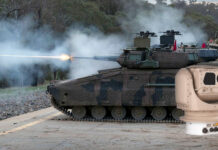According to the U.S. Marine Corps, the current program has the authority to procure up to 5,244 Mine Resistant Ambush Protected All Terrain Vehicles – M-ATVs, as funding becomes available. Under the contract, Oshkosh Corporation will produce and deliver M-ATVs as fast as possible to meet the urgent need in Afghanistan. Oshkosh Corporation is expected to eventually produce up to 1,000 vehicles a month. Oshkosh Corporation plans to reach that monthly mark by December 2009. The indefinite delivery indefinite quantity contract is a three-year contract with possible delivery orders up to $3.3 billion for the production, delivery and associated support of the M-ATV. It is anticipated that the first M-ATVs will be fielded before the end of the year. These vehicles will be used to complement the other tactical vehicles, including MRAPs, already in the theater of operations.
The M-ATV is defined as a separate category within the MRAP family of vehicles, designed to support small unit combat operations in highly restricted, rural, mountainous and urban environments. The vehicles will support mounted patrols, reconnaissance, security, convoy protection, communications, command and control and combat service support. This category will carry up to five personnel – four plus a gunner.
“The M-ATV is meant to augment the vehicle fleet so they can transport troops where they need to go safely,” said Brig.Gen. Michael M. Brogan, commander, Marine Corps Systems Command, and joint program executive officer of the MRAP Vehicle Program. It’s intended to be a survivable alternative to up armored HMMWVs.” he said. “The M-ATV procurement is the result of an extremely comprehensive and rigorous source selection process, which appropriately weighed survivability, mobility, maneuverability, production capability, price and other factors within the context of the urgent need for the procurement.” Gen. Brogan said the acquisition process determined the most capable and best performing vehicle against stringent survivability requirements. Extensive test and evaluation with volumes of empirical data were produced on which a “best value” decision was based. It was detailed, thorough and fair, and the results have been reviewed by an OSD peer review team made up of senior contracting officials. The MCSC Commander believes the M-ATV program will be as successful as the overall MRAP vehicle program. “We have taken delivery of more than 16,190 vehicles since we first released that initial request for proposals in November of 2006,” Brogan said, referring to MRAP.
The government used the same fundamental acquisition strategy as the original MRAP program: utilize initial criteria of survivability / mobility (screening for survivability and ability to produce); award IDIQ contracts; live fire test for survivability; use existing MRAP Joint Program Office infrastructure to procure, test, field, train and support the JUONS.



















